At this time last year, the Clippers still had Chris Paul, Blake Griffin, and DeAndre Jordan under contract, and were weighing the possibility of keeping that Big Three intact for the foreseeable future. Now, Paul is a Rocket, Griffin is a Piston, and Jordan’s future with the Clippers is very much in flux, given his pending player option decision.
A 10th-place finish in the Western Conference snapped the Clippers’ streak of six consecutive playoff appearances, a run that may very well have continued if Paul and Griffin had remained with the team. However, the franchise might be better off in the long run by not having its cap weighed down with lucrative, long-term contracts for a pair of injury-prone players who may be entering the tail end of their respective primes.
Here are five key questions facing the Clippers this summer:
 1. Did the Griffin trade represent the start of a rebuild or just another path to contention?
1. Did the Griffin trade represent the start of a rebuild or just another path to contention?
In their trade that sent Griffin to Detroit, the Clippers acquired Tobias Harris, Boban Marjanovic, and Avery Bradley. Bradley is an unrestricted free agent this summer, while Harris and Marjanovic will each see their current contracts expire in 2019, so it’s possible that none of those players will become long-term pieces for the organization. If the Clippers want to drastically reshape their roster, letting Bradley walk and shopping Harris and Marjanovic in trade talks are viable possibilities.
However, there have been signs since that blockbuster deal with the Pistons that the Clippers don’t intend to tear it all down. An extension for Doc Rivers was perhaps the most obvious signal that the team is simply retooling, since Rivers has expressed distaste in the past for going through a rebuild. 31-year-old sixth man Lou Williams also got an extension, inking a new three-year, $24MM contract that will cut into the team’s projected cap room for the next summer.
If the Clippers really wanted to blow things up, they likely wouldn’t have stopped after moving Griffin. Jordan was another prime trade candidate, and one who likely could have netted the Clips another valuable draft pick if he’d been moved in February. Instead, the team held onto him, continuing to discuss the possibility of a longer-term extension.
The Clippers have some flexibility to go in a number of directions, but a full-fledged rebuild seems unlikely. This looks like a team that changed directions, but still wants to compete for the playoffs and focus on win-now moves rather than looking several years down the road.
2. Will everyone exercise their player options?
When their offseason began, the Clippers’ roster featured four veterans holding player options for the 2018/19 season. Wesley Johnson ($6.13MM) has already opted in, leaving Milos Teodosic ($6.3MM), Austin Rivers ($12.65MM), and Jordan ($24.12MM) with decisions to make.
Of the three, Rivers seems like the surest bet to pick up his option. Doc’s son has established himself as a solid defender, and was more productive than ever on offense last season (15.1 PPG, .378 3PT%), so his contract is hardly an albatross. Still, he signed during the free agent boom of 2016, and probably wouldn’t match his option salary if he opts out.
Teodosic and Jordan are trickier cases. Injuries slowed Teodosic during his first NBA season, but the longtime EuroLeague standout was effective when he played. He’s unlikely to secure much of a raise on his option salary, but he could look for a team where he’d have a clearer role. With Rivers, Williams, Patrick Beverley, and Jawun Evans set to return, and the possibility of the Clippers adding another guard in the draft, the club has no shortage of potential ball-handlers.
Meanwhile, Jordan’s decision will have the greatest impact on the Clippers’ offseason. In fact, his potential free agency deserves a question of its own…
Read more
3. Will the Clippers bring back their centers?
A Clipper since 2008, Jordan is the last real holdover from the Lob City era, and there have been whispers that he might be ready to move on. The veteran center nearly left in free agency once already in 2015 — this time, Griffin, Paul, J.J. Redick, and Paul Pierce won’t be around to trap him in his house when he’s finalizing his decision.
Still, there’s no guarantee that Jordan will even reach free agency. His $24MM+ player-option salary is likely higher than any starting salary he’d receive on a multiyear offer on the open market. Jordan could probably secure a bigger overall payday with a more modest annual salary on a long-term deal. But would that be a more favorable outcome than exercising his $24MM+ option and trying his luck on the open market next year, when more teams will have cap room available?
Even if Jordan opts in, a trade remains a possibility. Rumors swirled around the 29-year-old leading up to February’s deadline, and while he stayed put at that point, the Clippers should have more options if they shop him again this summer.
Elsewhere at the center position, the Clippers will have a sneakily important decision to make on backup big man Montrezl Harrell, who is a restricted free agent this summer. An overlooked piece of the Paul trade with the Rockets last summer, Harrell enjoyed a breakout season in Los Angeles, averaging 14.0 PPG on 65.6% shooting in his final 43 games (20.2 MPG). I’d expect teams to have their eye on Harrell as a potential under-the-radar free agent target, so the Clips may face a tough decision on an offer sheet for the promising young big man.
4. What will the Clippers do with the 12th and 13th overall picks?
If the Clippers are worried about losing Jordan and/or Harrell, they’ll have a great opportunity to address their frontcourt in the draft. Having picked up the Pistons’ first-round pick in the Griffin deal, L.A. now holds two lottery selections, creating myriad possibilities for the franchise.
Texas A&M center Robert Williams, who has the potential to do many of the things Jordan does on the court, would be one possibility for the Clippers if he’s still on the board. If the Clips want to address their backcourt, Shai Gilgeous-Alexander and perhaps Collin Sexton could be available. There should be no shortage of wings too, with Lonnie Walker, Miles Bridges, and Zhaire Smith among the candidates to be on the board at No. 12.
If the Clippers aren’t eager to add two rookies to their rotation, there are other ways they could take advantage of owning two lottery picks, which brings us to our final question…
5. Will the Clippers make a major trade this summer?
The Clippers perhaps aren’t as well equipped as teams like the Celtics or Suns to put together a huge package in a bid for a star, but they hold several attractive trade pieces. Adding Harris to one or both of their 2018 first-rounders would be a good starting point for any offer. Depending on the target, the Clippers could also offer a number of expiring contracts or future first-round picks.
The most logical target for the Clippers might be Kawhi Leonard, a Los Angeles native whose relationship with the Spurs went through some turbulence during the 2017/18 season. If Leonard and the Spurs can’t come to an agreement on an extension this offseason and decide to explore trade avenues, San Antonio could do worse than replacing the star forward with Harris, Beverley, and a slew of draft picks.
The Clippers have also reportedly been eyeing Luka Doncic, one of the top prospects in this year’s draft. Doncic won’t last until No. 12, but if he slips to No. 4, which is believed to be a possibility, the Grizzlies may be a logical trade partner for Los Angeles. Memphis wants to return to the playoffs in 2019 and is believed to be open to discussing a trade involving its top pick. If the Clippers offered up one or both of their lottery selections, along with a player or two that could help Memphis immediately, I think the Grizzlies would listen.
Here’s where things currently stand for the Clippers financially:
Guaranteed Salary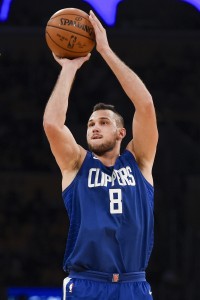
- Danilo Gallinari ($21,587,579)
- Tobias Harris ($14,800,000)
- Lou Williams ($8,000,000)
- Boban Marjanovic ($7,000,000)
- Wesley Johnson ($6,134,520): Exercised player option
- Sam Dekker ($2,760,095)
- Jawun Evans ($1,378,242)
- Sindarius Thornwell ($1,378,242)
- Carlos Delfino ($650,000) — Waived via stretch provision
- Miroslav Raduljica ($252,043) — Waived via stretch provision
- Total: $63,940,721
Player Options
Team Options
Non-Guaranteed Salary
Restricted Free Agents
Unrestricted Free Agents / Other Cap Holds
- Avery Bradley ($13,213,484): Bird rights
- No. 12 overall pick ($3,179,248)
- No. 13 overall pick ($3,020,246)
- Total: $19,412,978
Projected Salary Cap: $101,000,000
Projected Cap Room: $13,182,757
- With three veterans holding player options, there are a number of potential scenarios in play for the Clippers’ cap outlook this summer. For our cap projection, we’ve counted the team’s eight guaranteed salaries, Beverley’s non-guaranteed salary, cap holds for the two lottery picks, and Rivers’ player-option salary. The Clips’ total team salary in that scenario is $87,817,243.
- This projection assumes that Jordan and Teodosic both opt out, which is far from a lock. If either player opts in, L.A. will most likely operate as an over-the-cap team, barring other trades and/or cuts.
Footnotes:
- Williams’ salary becomes guaranteed for $125K on the first day of the 2018/19 regular season.
Note: Rookie scale cap holds are estimates based on salary cap projections and could increase or decrease depending on where the cap lands.
Salary information from Basketball Insiders was used in the creation of this post. Photos courtesy of USA Today Sports Images.
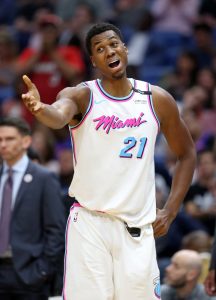 1. Will the Heat trade Hassan Whiteside?
1. Will the Heat trade Hassan Whiteside?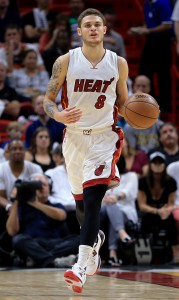
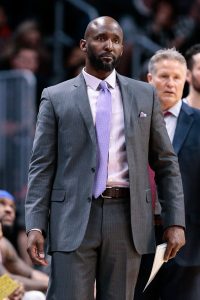
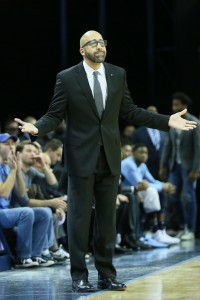

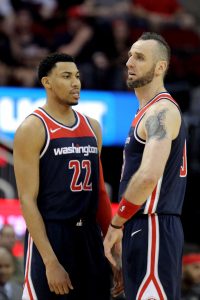
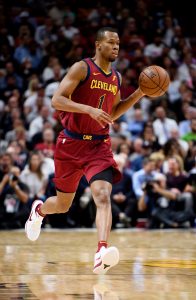
 1. What will the Nuggets do with
1. What will the Nuggets do with 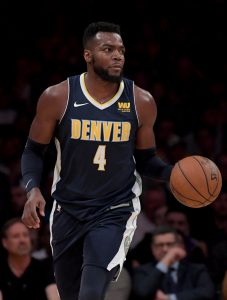
 1. Did the Griffin trade represent the start of a rebuild or just another path to contention?
1. Did the Griffin trade represent the start of a rebuild or just another path to contention?
